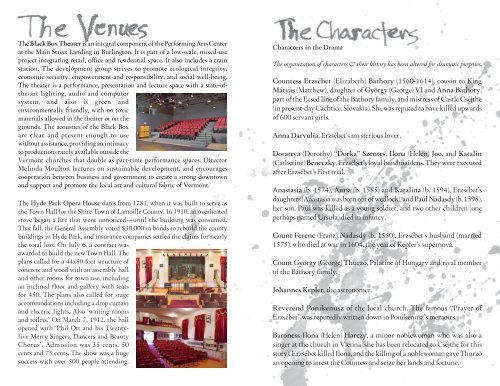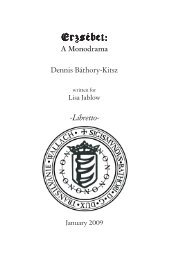Bolder Sounds 20 years of creative sample libraries - Báthory Erzsébet
Bolder Sounds 20 years of creative sample libraries - Báthory Erzsébet
Bolder Sounds 20 years of creative sample libraries - Báthory Erzsébet
Create successful ePaper yourself
Turn your PDF publications into a flip-book with our unique Google optimized e-Paper software.
The Black Box Theater is an integral component <strong>of</strong> the Performing Arts Center<br />
at the Main Street Landing in Burlington. It is part <strong>of</strong> a low-scale, mixed-use<br />
project integrating retail, <strong>of</strong>fice and residential space. It also includes a train<br />
station. The development group strives to promote ecological integrity,<br />
economic security, empowerment and responsibility, and social well-being.<br />
The theater is a performance, presentation and lecture space with a state-<strong>of</strong>the-art<br />
lighting, audio and computer<br />
system, and also is green and<br />
environmentally friendly, with no toxic<br />
materials allowed in the theater or on the<br />
grounds. The acoustics <strong>of</strong> the Black Box<br />
are clear and present enough to use<br />
without assistance, providing an intimacy<br />
to productions rarely available outside the<br />
Vermont churches that double as part-time performance spaces. Director<br />
Melinda Moulton lectures on sustainable development, and encourages<br />
cooperation between business and government to create a strong downtown<br />
and support and promote the local art and cultural fabric <strong>of</strong> Vermont.<br />
The Hyde Park Opera House dates from 1781, when it was built to serve as<br />
the Town Hall for the Shire Town <strong>of</strong> Lamoille County. In 1910, an overheated<br />
stove began a fire that went unnoticed—until the building was consumed.<br />
That fall, the General Assembly voted $30,000 in bonds to rebuild the county<br />
buildings in Hyde Park, and insurance companies settled the claims for nearly<br />
the total loss. On July 6, a contract was<br />
awarded to build the new Town Hall. The<br />
plans called for a 44x80-foot structure <strong>of</strong><br />
concrete and wood with an assembly hall<br />
and other rooms for town use, including<br />
an inclined floor and gallery with seats<br />
for 450. The plans also called for stage<br />
accommodations including a drop curtain<br />
and electric lights. Also ‘waiting rooms<br />
and toilets.’ On March 7, 1912, the hall<br />
opened with ‘Phil Ott and his Twentyfive<br />
Merry Singers, Dancers and Beauty<br />
Chorus’. Admission was 35 cents, 50<br />
cents and 75 cents. The show was a huge<br />
success with over 500 people attending.<br />
Characters in the Drama<br />
The organization <strong>of</strong> characters & their history has been altered for dramatic purposes.<br />
Countess <strong>Erzsébet</strong> (Elizabeth) <strong>Báthory</strong> (1560-1614), cousin to King<br />
Mátyás (Matthew), daughter <strong>of</strong> György (George) VI and Anna <strong>Báthory</strong>,<br />
part <strong>of</strong> the Ecsed line <strong>of</strong> the <strong>Báthory</strong> family, and mistress <strong>of</strong> Castle Cséjthe<br />
(in present-day Cachtice, Slovakia). She was reputed to have killed upwards<br />
<strong>of</strong> 600 servant girls.<br />
Anna Darvulia, <strong>Erzsébet</strong>’s mysterious lover.<br />
Dorattya (Dorothy) “Dorka” Szentes, Ilona (Helen) Joo, and Katalin<br />
(Catherine) Beneczky, <strong>Erzsébet</strong>’s loyal handmaidens. They were executed<br />
after <strong>Erzsébet</strong>’s first trial.<br />
Anastasia (b. 1574), Anna (b. 1585) and Katalina (b. 1594), <strong>Erzsébet</strong>’s<br />
daughters (Anastasia was born out <strong>of</strong> wedlock), and Paul Nádasdy (b. 1598),<br />
her son. Paul was killed as a young soldier, and two other children (one<br />
perhaps named Ursula) died in infancy.<br />
Count Ferenc (Franz) Nádasdy (b. 1550), <strong>Erzsébet</strong>’s husband (married<br />
1575), who died at war in 1604, the year <strong>of</strong> Kepler’s supernova.<br />
Count György (George) Thurzó, Palatine <strong>of</strong> Hungary and rival member<br />
<strong>of</strong> the <strong>Báthory</strong> family.<br />
Johannes Kepler, the astronomer.<br />
Reverend Ponikenusz <strong>of</strong> the local church. The famous “Prayer <strong>of</strong><br />
<strong>Erzsébet</strong>” was reputedly written down in Ponikenusz’s memoirs.<br />
Baroness Ilona (Helen) Harczy, a minor noblewoman who was also a<br />
singer at the church in Vienna (she has been relocated to Cséjthe for this<br />
story). <strong>Erzsébet</strong> killed Ilona, and the killing <strong>of</strong> a noblewoman gave Thurzó<br />
an opening to arrest the Countess and seize her lands and fortune.



